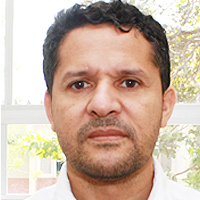Short-term responses to high-dose inhaled corticosteroid treatment in patients with chronic obstructive pulmonary disease with a fractional nitric oxide concentration over 35 parts per billion: A single-centre pre–post study
Published on: 6th October, 2020
OCLC Number/Unique Identifier: 8686101260
Introduction: There is currently no strategy for identifying chronic obstructive pulmonary disease (COPD) patients whose pulmonary function could benefit from inhaled corticosteroids. We investigated whether a 28-day regime of inhaled corticosteroids improved pulmonary function test results among COPD patients with a fractional exhaled nitric oxide concentration > 35 parts per billion.
Methods: This single-centre one-arm pre–post trial included COPD patients with a fractional exhaled nitric oxide concentration > 35 parts per billion treated at our institution from September 2018 to August 2019. Patients were administered budesonide (200 μg, 8 puffs daily) for 28 days. The primary outcome measure was the difference between the forced expiratory volume in 1 s (FEV1) at baseline and after 28 days of inhaled corticosteroid treatment. Secondary outcomes included differences in COPD Assessment Test scores, %FEV1, and that between the percent forced vital capacity (%FVC) at baseline and after 28 days of treatment.
Results: Twenty patients completed the 28-day inhaled corticosteroid regime. The mean difference in FEV1 between day 1 and day 28 was 340 mL (95% confidence interval: −100 to 770 mL; p = 0.122). The mean differences in secondary outcomes were: %FVC, −0.16% (95% confidence interval [CI]: −2.84 to 2.53%; p = 0.905); %FEV1, 1.63% (95%CI: −4.56 to 7.81%; p = 0.589); COPD Assessment Test score, −2.50 (95%CI: −5.72 to 0.72; p = 0.121).
Conclusion: The 28-day course of inhaled corticosteroids yielded no significant difference in FEV1 for COPD patients with a fractional exhaled nitric oxide concentration > 35 parts per billion.
Trial registration: University Hospital Medical Information Network Center, UMIN000034005. Registered 3 September 2018.
https://upload.umin.ac.jp/cgi-open-bin/ctr/ctr_view.cgi?recptno=R000038557
COPD and low plasma vitamin D levels: Correlation or causality?
Published on: 27th October, 2018
OCLC Number/Unique Identifier: 7905962979
Chronic obstructive pulmonary disease (COPD) is the third leading cause of death and its prevalence and incidence is also related to smoking behavior [1]. COPD is still a chronic inflammatory and progressive disease caused by multifactorial agents including environmental pollutants [2]. Besides that, it is emerging that endogenous epigenetic factors induced by lifestyle and environment [3] could play a role in the etiopathogenesis of the disease [4].
In the last years, several authors suggested that low vitamin D levels seem to be related with the increase of COPD manifestations [5]. Moreover, a multicentre, double-blind, randomised controlled trial documented that vitamin D supplementation protects against moderate or severe exacerbation of the disease, but not by upper respiratory infections [6]. However, low levels of vitamin D can be extended to many other diseases, including multiple sclerosis, diabetes, colon rectal cancer, headache or drug use [7-11]. Moreover, it is also important to remember that Vitamin D deficiency is common in high latitude regions, such as northern Europe, New Zealand, northern USA, and Canada where weaker ultraviolet B rays is not able to produce enough vitamin D. Finally, methodological factors (using low sensitivity methods) could contribute to misleading evaluation of circulating vitamin D levels. In any case, here we shall remind that vitamin D has a fundamental role in immunity [12]. In particular, it has been reported that vitamin D is able to shift the pro-inflammatory T-helper cell 1 to anti-inflammatory T-helper cell 2 [13]. Therefore, benefits of vitamin D supplementation in chronic diseases which directly or indirectly affect immune system are obvious. Today, the burden of COPD in never smokers is higher than previously believed. Therefore, more research is needed to unravel the characteristics of non-smokers COPD [1]. Notably, vitamin D levels are reported to be significantly lower in smoker’ssubjects than in non-smokers ones [14]. Therefore, low plasma vitamin D levels in COPD seems to be more a causality than a correlation.
A Case series on Asthma-COPD overlap (ACO) is independent from other chronic obstructive diseases (COPD and Asthma)
Published on: 30th July, 2021
OCLC Number/Unique Identifier: 9157820954
As we know that, Asthma and chronic obstructive pulmonary diseases are well characterized diseases, they can co-exist as asthma-COPD overlap (ACO). The co-existence of asthma-chronic obstructive pulmonary disease overlap (ACO) in chronic obstructive pulmonary disease (COPD) patients is often unrecognized. In patients with a primary diagnosis of COPD or Asthma, the identification of ACO has got implication for better prognosis and treatment. Such patients experience frequent exacerbations, poor quality of life, rapid decline in lung function and high mortality than COPD or Asthma alone. Inhalational steroids provide significant alleviation of symptoms in such patients and some studies suggest that the most severe patients may respond to biological agents indicated for severe asthma. Patients who have asthma with a COPD component tend to present with severe hypoxia because of Irreversible/fixed airway obstruction and impairment of the alveolar diffusion capacity by emphysematous changes. In contrast, patients with COPD who have an asthma component not only have exertional dyspnoea but also develop paroxysmal wheezing or dyspnoea at night or in the early morning. The criteria to diagnose asthma-COPD overlap (ACO) include positive bronchodilator response, sputum eosinophilia or previous diagnosis of asthma, high IgE and/or history of atopy. There is scarcity of literature available in country like India. We highlight the importance of identification of Asthma COPD overlap as different phenotype from COPD or asthma alone as it is challenging to diagnose ACO in India. We report 3 cases having both the features of asthma and COPD, later diagnosed with Asthma-COPD overlap.
Clinical significance of Urinary Amylase in Acute Pancreatitis
Published on: 27th June, 2017
OCLC Number/Unique Identifier: 7317596310
Acute pancreatitis forms a major bulk of our inpatient admission due to gall stone disease. Diagnosis of acute pancreatitis remains a challenge even now. Serum amylase remains the most commonly used biochemical marker for its diagnosis but its sensitivity can be reduced by late presentation, hyper-triglyceridemia and chronic alcoholism. We conducted a study to determine the levels of serum and urinary amylase in patients with acute pancreatitis and compared their sensitivity and correlation with CT findings vis-à-vis the severity of the disease. The study was taken as a post graduate research model in the Post graduate Department of General and Minimal Access Surgery, Govt. Medical College Srinagar, J&K, India 2014-2016 and submitted for the award of masters in General Surgery. A total number of 150 patients were enrolled in the studies which were admitted in our unit as acute pancreatitis. 73 (48.7%) belonged to the age group of 30-44 years, 15(10%) patients aged >60 years with 86 (57.3%) males and 64 (42.7%) females. We had 81 (54%) patients with biliary tract diseases, followed by 21 (14%) patients with worm induced, 20 (13.3%) had hyperlipidaemia and only 4 (2.7%) patients had post ERCP etiology. Tenderness in epigastrium was the presenting sign in 111 (74%), followed by chest signs in 25 (16.7%) patients, diffuse tenderness in 19 (12.7%), icterus in 11 (7.3%), low grade fever in 9 (6%) patients, shock in 5 (3.3%). Diabetes mellitus as a comorbidity was observed in 48 (32%) patients followed by hypothyroidism 37 (24.7%) patients. Hypertension was seen in 31 (20.7%) patients, COPD in 19 (12.7%) patients and obesity in 13 (8.7%) patients. Twenty two (14.7%) needed ICU admission; while as 128 (85.3%) were managed in the general ward. All the enrolled patients in our study were managed conservatively. Out of a total of 150 patients, 148 (98.7%) survived while as only 2 (1.3%) of our patients expired. At the time of admission in the hospital, 120 (80%) patients had serum amylase level of >450 U/L, 19 (12.7%) patients had 150-450 U/L levels while as 11 (7.3%) patients had <150 U/L serum amylase levels. CT has been shown to yield an early overall detection rate of 90% with close to 100% sensitivity after 4 days for pancreatic gland necrosis. The correlation of urinary amylase with the CECT Severity Scoring in a patient of acute pancreatitis is still ambiguous.
Long-term results of 10 years of observation of cured cases of pulmonary tuberculosis
Published on: 23rd September, 2022
Aim of the study: Conduct long-term monitoring of recovered patients with pulmonary TB and study the frequency of relapses of pulmonary TB and factors contributing to their development in the Republic of Tajikistan.Material and research methods: Of the total number of patients with pulmonary TB, 820 people in 2010-2011 after successful treatment, were transferred for further dispensary observation to PHC facilities, whose health status we monitored for 10 years (including 2020). Of the 820 patients, we were able to track the health status for 10 years in 622 patients (320 men and 302 women, age groups 19-44 years old - 330 people and 45-69 years old - 292 people). The rest - for various reasons were lost from further dispensary observation. All patients in PHC facilities annually during the period of dispensary observation underwent clinical, instrumental, laboratory, and X-ray examinations to exclude the recurrence of TB. Data for each patient were tracked using the National TB Registry OpenMRS data.Research results: The elimination of preventive anti-relapse measures in people with residual post-tuberculosis changes in the lungs led to an increase in the number of relapses of the disease. The analysis of the conducted studies shows that the incidence of relapses of pulmonary TB does not depend on the regions and the severity of TB burden, they often develop with insufficient follow-up after the end of treatment and inadequate preventive measures in dispensaries patients.The study of the reasons for the development of relapses makes it possible to timely identify a group of patients who need anti-relapse measures and prolongation of dispensary observation.Conclusion: Thus, the results of this observation revealed the occurrence of relapses within 10 years in 19.3% of cases. A retrospective analysis of the initial forms of the disease showed that relapses of pulmonary tuberculosis occurred more often in patients who had had fibrous-cavernous pulmonary tuberculosis, than in patients who had disseminated pulmonary TB, and less often after suffering infiltrative pulmonary TB. Relapses of the disease occurred more often in men aged 19-44 years. The results obtained indicate the development of relapses of pulmonary tuberculosis has a statistically significant dependence on the form of the initial disease, the presence of RPTCL, comorbid diseases such as HIV, diabetes mellitus, COPD, and the regularity of taking anti-TB drugs. At the same time, it turned out that the social status of all patients with relapses corresponds to the level of poverty, which should also be taken into account.
Stable COPD Picture through Exhaled Breath Condensate, Questionnaires and Tests. A Proof of Concept Study
Published on: 5th December, 2023
Background: Changes in lung structures persist in stable Chronic Obstructive Pulmonary Disease (COPD), but their correlation with the clinical picture remains unclear. The purpose of this study was to assess the stable COPD picture via the relationship between exhaled breath condensate (EBC) particle concentration and the Saint George Respiratory Questionnaire (SGRQ), COPD Assessment Test (CAT), and six-minute walking test (6 MWT). Methods: 12 stable COPD and 12 healthy subjects participated in the study. The EBC was collected with Rtube and analyzed using the Accusizer FxNano. Particle concentration was measured and correlated with the findings of the tools used to assess the health status and functional profile of COPD. The results’ analysis was performed with the Spearman’s test and the Mann-Whitney U - test.Results: The COPD group presented a worse picture of health status and functional profile compared to the healthy group. Correlations were observed between components of the SGRQ and CAT. The two groups presented similar levels of EBC particle concentrations, but the number of small particles was higher in COPD subjects. A correlation of the EBC particle concentration with the activity and total score of the SGRQ was only observed in the healthy group. Conclusion: The total particle number was similar in the COPD and healthy groups. A few correlations between the EBC particles and tools used were also observed. The use of EBC particle concentration to monitor COPD status cannot be claimed with confidence because of the small sample size. Further research is necessary, particularly in large-scale groups.
Effect of TAK242 on MCP-1 and TGF-β in COPD Rats
Published on: 13th March, 2024
Objective: To investigate the mechanism of MCP-1 and TGF-β regulation by TAK242 in COPD rats. Methods: Thirty-six SD rats were randomly divided into normal, COPD control, and TAK242 groups. The normal group was freely fed, and the other groups used the method of fumigation plus lipopolysaccharide tracheal drip to establish an experimental animal model of COPD. After successful modeling, each experimental group received 0.9% NaCl solution and corresponding drugs by intraperitoneal injection for 7 d. After drug administration, lung function was examined; pathological changes in lung tissue were observed by light microscopy with hematoxylin-eosin staining; mRNA expression of MCP-1 and TGF-β was detected by q-PCR; and protein expression of MCP-1 and TGF-β in lung tissue was detected by Western blot and IHC, TGF-β protein expression in rat lung tissue. Results: Compared with the normal group, rats in the COPD control group showed signs and symptoms of COPD, decreased lung function, and increased expression of MCP-1 and TGF-β. The TAK242 group showed decreased expression of MCP-1 and TGF-β compared to the COPD control group. Conclusion: MCP-1, and TGF-β played a crucial role in the early stage of COPD fibrosis. TAK242 could ameliorate airway inflammation and inhibit the progression of COPD lung fibrosis in pre-existing rats in COPD model rats.
An Interesting Case of COPD Exacerbation Presenting with Mixed Features of Intracranial Hypertension and Hypercapnic Encephalopathy
Published on: 2nd July, 2024
Background: Idiopathic intracranial hypertension (IIH or pseudotumor cerebri) has two major morbidities: papilledema with visual loss and disabling headache. Intracranial Venous Hypertension (IVH) is a fundamental mechanism of IIH. Although traditionally considered limiting to the central nervous system, evidence suggests IIH as a systemic disease associated with cardiorespiratory disorders, which has been far less comprehended. Case Report: A 60-year-old female with Chronic Obstructive Pulmonary Disease (COPD) was admitted for dyspnea and developed a coma with a pH of 7.01 and pCO2 of 158 mmHg. She was intubated and had persistent nuchal rigidity, a brief myoclonus episode with a negative electroencephalogram, and negative CT head studies. A Lumbar Puncture (LP) revealed elevated opening pressure (35 cmH2O) with normal Cerebral Spinal Fluid (CSF) studies. Her nuchal rigidity improved after the removal of 40 mL CSF. The ophthalmology examination the next day after her the large volume LP didn’t show visual loss or papilledema. The patient improved clinically and was extubated two days later. Her echocardiogram showed a dilated right ventricle with pulmonary hypertension. The patient was discharged home.Discussion: IIH is different from hypercapnic encephalopathy and characterized by increased intracranial pressure with papilledema, vision loss, and debilitating headache. Hypercapnia-induced increased intracranial venous flow and pulmonary hypertension-caused elevated central venous pressure with consequent outflow resistance lead to IVH. In hypercapnic encephalopathy, the presentation is mostly cognitive changes. In this case, nuchal rigidity with a negative CT head scan triggered the investigation of IIH. Conclusion: A deep understanding of the relationship between COPD and IIH is vital. There is insufficient evidence to recommend routine eye examinations in COPD patients for papilledema and to conduct a pulmonary function test for a newly diagnosed IIH patient. However, we highly suggest a timely ophthalmology exam prior to performing an LP in COPD patients with suspecting IIH to avoid unnecessary procedures and meanwhile improve clinical outcomes.
Effect of Pulmonary Rehabilitation on Non-obstructive Disease Congenital Kyphoscoliosis Patient in Kuwait
Published on: 18th July, 2024
A case study of a non-COPD (Chronic Obstructive Pulmonary Disease) patient with congenital kyphoscoliosis to see the effect of pulmonary rehabilitation after 36 sessions given for chest disease in Kuwait with signs and symptoms, physical capacity, functional level, and Quality of life.
Current Practices for Severe Alpha-1 Antitrypsin Deficiency Associated COPD and Emphysema
Published on: 26th July, 2024
Alpha-1 antitrypsin deficiency is a genetic disorder that can lead to chronic obstructive pulmonary disease and emphysema. Although it is the most well-studied genetic risk factor for emphysema, data is still scarce. Traditionally, medical therapy is similar to standard chronic obstructive pulmonary disease patients. Over the past several decades, enzyme augmentation therapy has emerged as a highly utilized alpha-1 antitrypsin-specific therapy. It has become the standard of care for severe alpha-1 antitrypsin deficiency despite unclear effects on a multitude of clinical outcomes. Significant data supports interventional therapies, including lung volume reduction surgery and bronchoscopic lung volume reduction, for chronic obstructive pulmonary disease patients without alpha-1 antitrypsin deficiency. These interventions have less robust data in the treatment of alpha-1 antitrypsin-induced chronic obstructive pulmonary disease. This review will explore the data regarding various treatment options for severe alpha-1 antitrypsin deficiency associated with chronic obstructive pulmonary disease and emphysema.
Effectiveness of Intercostal Stretch Technique on Pulmonary Conditions: A Narrative Review
Published on: 13th September, 2024
Background: The Intercostal Stretch Technique is one of the physiotherapy techniques that is used to solve different respiratory problems. It is used for increasing chest expansion and diaphragm excursion improvement and also intra-thoracic lung volume. Aim: The study aims to evaluate the effectiveness of the intercostal stretch technique.Methodology: A narrative review. In this study, an RCT study was used to review the intervention.Results: Several articles are used to discuss the effectiveness of the intercostal stretch technique. In stable COPD, diaphragmatic breathing and the intercostal stretch technique both work equally well to improve chest expansion and functional capacity while lowering dyspnea. Research has shown that IC stretch outperforms the anterior basal lift technique in lowering heart and respiratory rates while increasing oxygen saturation. According to this study, IC stretching in conjunction with breathing control may improve dynamic lung parameters, particularly FEV1/FVC%, more than breathing control alone. Patients with COPD have an increased functional exercise capacity and reduced dyspnea when aerobic training and respiratory muscle stretching are combined. Conclusion: Different articles demonstrated that IC stretch improved lung function, expired tidal volume, decreased dyspnea, and increased chest expansion.
Obesity in Patients with Chronic Obstructive Pulmonary Disease as a Separate Clinical Phenotype
Published on: 19th September, 2024
Chronic obstructive pulmonary disease (COPD) is a heterogeneous, progressive disease characterized not only by pathological changes in the lungs but also by significant extrapulmonary manifestations and serious concomitant diseases. The current problem for the study is the features of the relationship between COPD and adipose tissue since there are contradictory data in the literature. This review presents studies that claim that obesity aggravates the course of COPD, as well as the results of studies that describe the “obesity paradox” in patients with COPD. Due to the lack of unambiguous data, it is necessary to continue studying this problem to optimize the tactics of managing this group of patients and draw up clear recommendations for patients with COPD.
Influence of COPD on the Diaphragm and Muscles of the Lower Limbs
Published on: 1st October, 2024
Chronic obstructive pulmonary disease (COPD) is associated with numerous comorbidities, including muscle involvement which consists of changes in the structure and function of peripheral and respiratory muscles. Ultrasound can provide a non-invasive assessment of muscle damage. Ultrasound assessment of the quadriceps contractility index (Qci) is feasible, rapid, simple, and reliable. Numerous studies have demonstrated that Qci is linked to the severity of COPD, clinical symptoms, and respiratory muscle activity. Furthermore, ultrasound makes it possible to observe the dynamics of the diaphragm by measuring its amplitude, its contraction speed, and the duration of each contraction phase. Ultrasound examination of muscle damage in COPD could constitute a promising new tool to assess the severity of the disease.
















